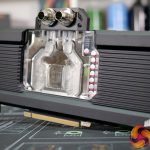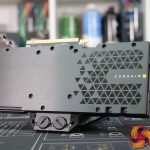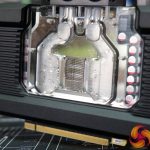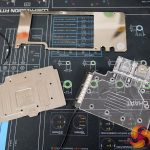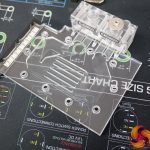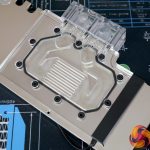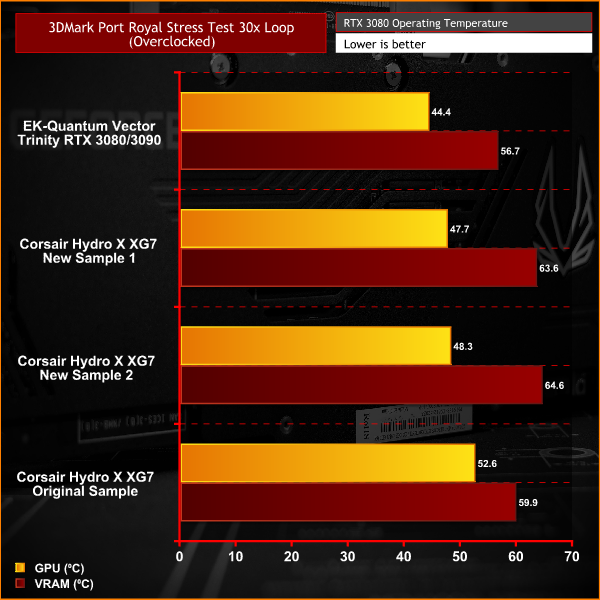Today we look back on a review from last month where we tested three GPU water blocks for RTX 30-series reference cards. In that review, we tested using a Zotac RTX 3080 Trinity OC to compare the performance of water block offerings from EKWB, Alphacool and Corsair. The results threw up some interesting figures, so Corsair sent us two more samples of the XG7 to see if our findings changed.
Timestamps:
The original review concluded that the best overall GPU water block on the day was the EK-Quantum Vector. The Alphacool block had some issues with VRAM temperature, which the company is looking into, and the Corsair XG7 looked pretty average across the board in terms of the thermal performance.
While testing the new Corsair XG7 samples, we also thought it was a good time to take a look at EKWB's new Active Backplate for RTX 30 reference design cards. These active backplates were supposed to be included in the original review but samples were not ready in time.
To ensure testing is fair and accurate, the same test bench as in the original review is used during the retest. Testing is conducted in the same test room as before and the ambient temperature is between 18⁰C-20⁰C, which is the same as before.
Corsair Hydro X Series XG7 RGB 30-Series Reference GPU Water Block (3090/3080):
Price: £154.99
Backplate price: Included in kit
Features:
- Precision CNC machined nickel-plated copper cold plate with over 50 cooling fins positioned directly over the GPU die for optimal heat transfer.
- Terminal block with G1/4” fittings featuring a design inspired by the iconic Corsair Dominator Platinum memory appearance.
- A full cover aluminium backplate that completely covers vulnerable components on the rear of the PCB is included in the kit.
- Built-in RGB lighting with 16 individually addressable LEDs, customisable via Corsair iCUE software (controller sold separately) or synchronised with the motherboard using the supplied 3-pin 5V header cable.
- Pre-applied thermal compound and thermal pads for speedy installation.
Technical Specification:
- Warranty: 3-Year
- Port Thread: G1/4″ BSPP
- Cold Plate Material: Nickel-Plated Copper
- Fluid Chamber Material: PMMA
- Operating Temperatur:e 60°C coolant temperature
EK-Quantum Vector Trinity RTX 3080/3090 Active Backplate D-RGB – Plexi
Price: €117.56
A new terminal block replaces the original and links the water block and active backplate together, meaning that the whole enclosure requires just one inlet and outlet, eliminating additional tubing and clutter.
The active backplate directly cools PCB hotspots on the back of the card, as well as VRM components and VRAM chips located on the back of the RTX 3090.
A wide 6 fin channel array is machined from nickel-plated electrolytic copper, directly covering critical components, while the top is machined from Acrylic and sealed with PEDM o-rings. The remaining parts of the backplate are manufactured from nickel-plated aluminium.
Technical Specification:
- Dimensions: (LxHxW) – 231x124x15mm
- D-RGB cable length: 500mm
- D-RGB LED count: 8
- D-RGB connector standard 3-pin (+5V, Data, Blocked, Ground)
Performance Testing:
To measure the thermal performance of these three GPU water blocks we devised an easily repeatable series of tests, using the 3Dmark Time Spy Extreme and Port Royal stress tests to simulate GPU load during gaming workloads.
A simple custom loop was constructed and equipped with a 360mm radiator, triple 120mm fans and a 120mm pump/res combo that was connected to each water block individually during testing. GPU temperature and frequency were recorded during each test using GPU-Z and averages calculated for analysis.
Test system specification
- CPU: Intel Core i9-9900KS
- Motherboard: Gigabyte Z390 Aorus Xtreme
- Memory: 32GB (4 x 8GB Modules) Aorus RGB DDR4-3600
- Graphics card: Zotac RTX 3080 Trinity OC
- Storage: 500GB Plextor M9PeGN NVMe PCIe Gen3x4
- Case: Open test bench
- CPU cooler: Cooler Master Hyper 212 Black Edition
- Radiator: EK-CoolStream PE 360 (Triple)
- Pump/Res combo: EK-Quantum Kinetic TBE 120 DDC PWM D-RGB – Acetal
- Fans: 3 x EK-Vardar S 120ER D-RGB
- Power Supply: Seasonic Prime PX-850 80+ Platinum
For the first series of tests, a custom fan curve was configured to replicate the fan speed of the stock Zotac cooler. As the GPU core temperature increases, so do the fan speed of the 360mm radiator fans, which forms part of the cooling loop. This allowed us to compare water block performance against the stock cooler.
The 3DMark Time Spy Extreme stress test was then run in a loop 30 times, which lasts approximately 30 minutes, allowing the graphics card to reach its steady-state temperature. The board power limit was set to 105%. Average GPU core temperature, VRAM temperature and GPU frequency were calculated to measure performance.
A second run of the Time Spy stress test 30x loop followed, but with the GPU and VRAM overlocked (GPU core +140MHz, VRAM + 500MHz) to see how this impacted temperature and frequency. The same measurements were taken and plotted in the charts below.
To measure the three water blocks performance against each other under controlled conditions, the fan speed was then set to a fixed 1300RPM which also normalised noise levels. By using the 3DMark Port Royal stress test in a loop 30 times, we could measure GPU core temperature, VRAM temperature and frequency again and analyse the results to see which water block provided the optimal thermal performance and frequency.
Performance Analysis: New Corsair XG7 Samples.
Both of the new XG7 samples produce an improvement in thermal performance during all three tests. New sample 1 is marginally the better out of the two but this new test data brings the XG7 closer to the EKWB water block compared with the sample from our original review.
This could mean that either the original sample was bad, but still within Corsair tolerance, or that since we received the original sample (a very early production sample) Corsair could have refined the manufacturing process, improving performance and tightening manufacturing tolerances. Either way, the improvement in GPU core temperature is noticeable during gaming workloads.
EKWB Active Backplate Performance:
There is plenty of content already available showing the performance of the EK Active Backplate when used with an RTX 3090, we tested the backplate with a reference design RTX 3080 to see if there is any benefit of using this combination.
There was no noticeable reduction in the GPU core temperature. There is a minor reduction in the VRAM temperature, so removing some residual heat from the back of the PCB is helping to keep the temperature down. However, we would expect a more substantial improvement in VRAM temperature using the backplate in conjunction with an RTX 3090, due to the memory chips being placed on the back side of the PCB.
Closing Thoughts
Both new samples of the XG7 water block sent from Corsair offered a noticeable decrease in GPU core temperature compared with the sample used in our original review. Meaning that the performance of the XG7 is closer to the EK-Quantum Vector block from the original review, which is a testament to Corsair’s R&D. Let's not forget that Corsair is still relatively new to custom water cooling.
We are not entirely sure why the original sample didn’t live up to expectations in terms of thermal performance, the block was re-mounted and tested several times but there was no improvement. It was a very early sample of the XG7 reference 3090/3080 block, possibly even pre-production. Corsair could have since refined its manufacturing process and reduced tolerances which is why both new samples performed better, and very closely compared to each other.
Or it could simply be that the original sample was a poor one but still within Corsair performance specification. The thermal performance of the original sample wasn’t horrendous, but we can clearly see an improvement with the new samples which will please users that want to keep all their custom cooling within the Corsair ecosystem.
With this in mind, my overall opinion on the Corsair XG7 RTX 3090/3080 reference water block has definitely improved. I still think it is a very aesthetically pleasing water block with a very simple installation process. However, the improvement in thermal performance with these new samples means that it closes the gap to its rivals.
The EKWB Active backplate is a very nice product, especially for RTX 3090 owners who will no doubt see the most benefit from owning one. However, RTX 3080 owners may not benefit from spending over £100 on top of the cost of a GPU water block when seeing the minimal gain in the thermal performance that the active backplate offers on these cards. I do believe that the active backplate is a must-have for RTX 3090 owners that put a high load on the card for long periods.
We did encounter an issue with the Active Backplate during installation though, and it is an issue that EKWB needs to look into pretty quickly. When installing the backplate during the video, one of the retaining screws wasn’t long enough to fully engage with the GPU water block standoff, so the screw wouldn’t tighten up at all, luckily we had a 2mm longer screw to hand, and that allowed us to fully tighten up the backplate as intended.
When disassembling the system after testing, another one of the backplate screws randomly flew out of the backplate too. This could have been disastrous if the screw had come out while the system was running, as it could have potentially have landed somewhere on the motherboard or in the power supply and caused a short, which in turn could have damaged the system. Luckily this didn’t happen but EKWB could have some very unhappy customers on their hands if this was to happen.
That potential issue aside, the EKWB Active Backplate looks great when installed, with RGB lighting now on both sides of the card. Installation doesn’t take too long and the online instructions are easy to follow. The Active Backplate might not be of great value for money to RTX 3080 users but great for owners of the flagship RTX 3090.
Discuss on our Facebook page HERE.
KitGuru says: With an improvement in thermal performance seen in these new XG7 samples from Corsair, the performance is much closer to that of the equivalent RTX 3080 reference block from EKWB.
 KitGuru KitGuru.net – Tech News | Hardware News | Hardware Reviews | IOS | Mobile | Gaming | Graphics Cards
KitGuru KitGuru.net – Tech News | Hardware News | Hardware Reviews | IOS | Mobile | Gaming | Graphics Cards


